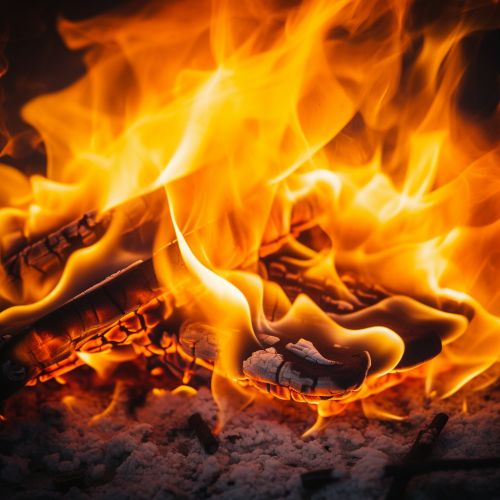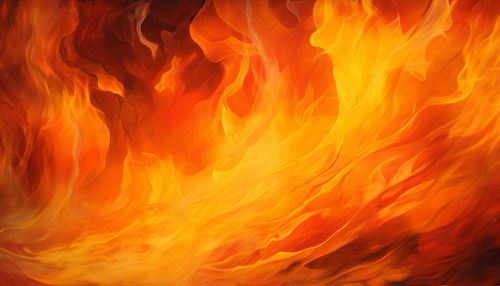The Chemistry of Fire and Combustion
Introduction
Fire, a manifestation of combustion, is a chemical reaction that releases heat and light. It is a complex process that involves a series of reactions between a fuel and an oxidizer, often oxygen from the air. The chemistry of fire and combustion is a fascinating field that encompasses various disciplines such as physical chemistry, thermodynamics, and kinetics.


Chemistry of Fire
Fire is a result of a chemical reaction known as combustion. This process involves the reaction of a substance (fuel) with an oxidizing agent (usually oxygen) to produce heat and light. The fuel can be a solid, liquid, or gas, while the oxidizing agent is typically oxygen in the air.
Combustion Reaction
The general equation for a combustion reaction is as follows:
Fuel + Oxidizer → Heat + Light + Combustion Products
In the case of a hydrocarbon fuel like methane (CH4), the combustion reaction with oxygen can be represented as:
CH4 + 2O2 → CO2 + 2H2O + Heat + Light
This reaction is exothermic, meaning it releases heat. The heat produced then sustains the reaction, causing more fuel to react with the oxygen, thereby sustaining the fire.
Combustion Products
The products of a combustion reaction typically include water (H2O), carbon dioxide (CO2), and various other compounds depending on the fuel and the conditions of combustion. Incomplete combustion, which occurs when there is insufficient oxygen, can produce carbon monoxide (CO), a poisonous gas, and soot, which consists of unburned carbon particles.
Phases of Combustion
Fire undergoes several phases during its lifecycle: ignition, growth, fully developed, and decay. Each of these phases has distinct chemical and physical characteristics.
Ignition
Ignition is the initial phase of combustion. It requires an ignition source, such as a spark or heat, to initiate the chemical reaction between the fuel and the oxygen. The ignition temperature is the minimum temperature at which a fuel will start to burn.
Growth
During the growth phase, the fire spreads as more fuel is heated to its ignition temperature. The heat from the combustion reaction causes adjacent fuel to heat up and reach its ignition temperature, causing the fire to spread.
Fully Developed
In the fully developed phase, all available fuel is burning. The fire reaches its maximum size and heat output during this phase. The combustion is typically complete during this phase, with the primary combustion products being water vapor and carbon dioxide.
Decay
The decay phase occurs when the fuel is consumed, and the fire starts to die down. The combustion process slows, and the heat output decreases. Eventually, the fire goes out when all the fuel is consumed, or the supply of oxygen is cut off.
Factors Affecting Combustion
Several factors can affect the combustion process and the characteristics of a fire. These include the type of fuel, the availability of oxygen, and the presence of heat.
Fuel
The type of fuel can greatly affect the combustion process. Different fuels have different ignition temperatures and burn at different rates. The chemical composition of the fuel also determines the products of combustion.
Oxygen
Oxygen is a key component of the combustion process. Without sufficient oxygen, combustion cannot occur. The availability of oxygen can affect the rate of combustion and the completeness of the combustion process.
Heat
Heat is both a product and a requirement of the combustion process. The initial heat needed to start the combustion process is provided by an ignition source. Once the combustion process starts, it produces heat, which sustains the reaction.
Safety and Environmental Considerations
The combustion process, while useful for many applications, also poses several safety and environmental concerns. These include the production of harmful combustion products, the risk of uncontrolled fires, and the contribution to climate change.
Combustion Products
Incomplete combustion can produce harmful substances such as carbon monoxide and soot. Carbon monoxide is a poisonous gas that can cause harm to humans and animals. Soot, on the other hand, can contribute to air pollution and respiratory problems.
Fire Safety
Uncontrolled fires can cause significant damage and pose a risk to life and property. Understanding the chemistry of fire and combustion is crucial for fire safety. It can help in the prevention of fires and in the development of effective firefighting strategies.
Climate Change
The combustion of fossil fuels contributes to climate change by releasing large amounts of carbon dioxide, a greenhouse gas, into the atmosphere. Understanding the chemistry of combustion can help in the development of cleaner and more efficient combustion processes.
